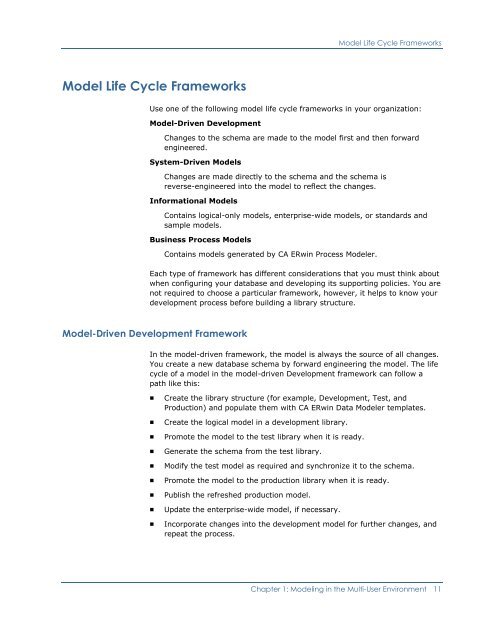CA ERwin Model Manager Implementation Guide
CA ERwin Model Manager Implementation Guide
CA ERwin Model Manager Implementation Guide
You also want an ePaper? Increase the reach of your titles
YUMPU automatically turns print PDFs into web optimized ePapers that Google loves.
<strong>Model</strong> Life Cycle Frameworks<strong>Model</strong> Life Cycle FrameworksUse one of the following model life cycle frameworks in your organization:<strong>Model</strong>-Driven DevelopmentChanges to the schema are made to the model first and then forwardengineered.System-Driven <strong>Model</strong>sChanges are made directly to the schema and the schema isreverse-engineered into the model to reflect the changes.Informational <strong>Model</strong>sContains logical-only models, enterprise-wide models, or standards andsample models.Business Process <strong>Model</strong>sContains models generated by <strong>CA</strong> <strong>ERwin</strong> Process <strong>Model</strong>er.Each type of framework has different considerations that you must think aboutwhen configuring your database and developing its supporting policies. You arenot required to choose a particular framework, however, it helps to know yourdevelopment process before building a library structure.<strong>Model</strong>-Driven Development FrameworkIn the model-driven framework, the model is always the source of all changes.You create a new database schema by forward engineering the model. The lifecycle of a model in the model-driven Development framework can follow apath like this:■■■■■■■■■Create the library structure (for example, Development, Test, andProduction) and populate them with <strong>CA</strong> <strong>ERwin</strong> Data <strong>Model</strong>er templates.Create the logical model in a development library.Promote the model to the test library when it is ready.Generate the schema from the test library.Modify the test model as required and synchronize it to the schema.Promote the model to the production library when it is ready.Publish the refreshed production model.Update the enterprise-wide model, if necessary.Incorporate changes into the development model for further changes, andrepeat the process.Chapter 1: <strong>Model</strong>ing in the Multi-User Environment 11
















